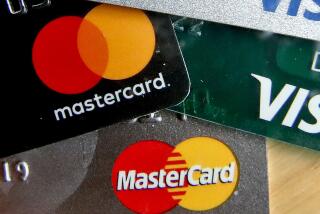E-Commerce May Help Americans Learn to Love âSmartâ Cards
When Atty. Gen. Janet Reno initiated antitrust action against Visa and MasterCard last week, she blasted the credit card companies for stifling development of competing payment systems such as âsmartâ cards. But if the allegation is true, itâs only one of several reasons why the high-tech cards are facing an uphill battle for acceptance in the U.S.
Despite their widespread use in Europe and their growing popularity in Asia, Americans have yet to embrace smart cards. For more than a decade, the plastic cards with embedded computer microchips have failed to crack the U.S. market, which normally welcomes new technologies.
Now a new round of optimism is brewing about what could be the âkiller applicationâ for smart cards: Internet commerce.
If e-commerce catches on, smart cards could spread from the virtual world to a variety of everyday uses. Already, smart card technology is finding its way into such commonplace items as entry pass cards and prepaid phone cards. Some observers envision the cards eventually supplanting traditional credit, identification and automated teller machine cards.
âSmart cards will be personalized to fit into the life you lead and make your life more convenient and easier to deal with,â said Bill Barr, a Bellcore executive who also serves as president of the Smart Card Forum, a 190-member industry group based in McLean, Va.
A smart card closely resembles a credit card, except for a 5-by-10-millimeter chip embedded in the plastic. Some of the chips are memory-only and are used for keeping track of things like the dollar value remaining on a prepaid phone card. Other cards contain microprocessors that can manipulate data and therefore record transactions ranging from bank account withdrawals to online purchases. (During a transaction, the card is inserted into or waved in front of a device that reads data on the chip.)
But the cards can also store critical health-care data, including medical records and insurance information. With a simple swipe, a user could gain entry to a school building and also record attendance. Companies can issue cards to keep track of customersâ spending and reward them with loyalty points, the way airlines do with frequent-flier miles.
Personal identification numbers or such biometric identifiers as fingerprints can provide the same security protections that are now common in ATM cards.
Despite all this, U.S. companies havenât made significant inroads beyond simple uses like prepaid calling cards and data de-scramblers in set-top boxes for satellite TV systems.
âA lot of people just assumed that what worked internationally would work here,â said Dan Cunningham, president and chief executive of the Smart Card Industry Assn. in Lawrenceville, N.J. âThe industry has finally come to the realization that this marketâs different, that you canât force it to grow and that it will grow at its own pace and in its own way.â
Last year, 962 million smart cards were sold worldwide, and that number is projected to grow 390% to more than 4.7 billion in 2002, according to San Jose market research firm Dataquest. And while sales of cards in the U.S. amounted to a mere 8.4 million last year, they are expected to balloon to 265 million by 2002. Even so, the U.S. share of the global market will still be a paltry 5.6% four years from now, according to Dataquestâs projections.
Smart card usage spread throughout Europe because the telecommunications infrastructure there--particularly in France, where the cards originated--is less well developed than in the U.S. As a result, the cost and hassle of using a telephone line makes credit card authorizations more difficult. The chip inside a smart card, by contrast, can be checked by a card reader that doesnât have to connect with a central computer over a phone line.
âDoes the U.S. telecom industry want to trash a system it already has in place to go to a new system? The answer is no--thereâs no reason for them to do that,â said Jonathan Cassell, a senior industry analyst at Dataquest.
Perhaps more central to the success of smart cards in Europe is the fact that government agencies have mandated their use.
âIf one person in the German health-care ministry decides theyâre going to use smart cards, theyâre going to use smart cards,â Barr said.
European countries have also overcome a problem that remains a major hurdle in the U.S.: deciding on a single technological standard to employ. In Europe, a government ministry or a few large banks can set a standard outright. But here, different banks are backing different kinds of smart card systems in a battle reminiscent of the VHS-Beta war for videocassette recorders.
But most merchants donât want to install more than one kind of smart card reader. As a result they havenât installed any, said Dudley Nigg, executive vice president for Wells Fargo Bankâs online financial services group.
âHere, things have to emerge in a more open environment,â he said. âSometimes it takes a lot longer, but it creates a more innovative environment as well.â
U.S. pilot programs have yielded clues about consumer tastes. The largest such experiment, underway on Manhattanâs Upper West Side, involves about 60,000 Chase Manhattan Bank and Citibank customers who last year received new ATM cards with smart card chips.
The typical smart card purchase is for less than $5 and is made at a âlow-end merchantâ like a drugstore or coffee stand, said Mike Tempora, vice president of the U.S. chip card products group for MasterCard, which conducted the pilot program with Visa. But Tempora said he sees the most promise for self-serve purchases at laundry machines, parking meters and vending machines âwhere, quite frankly, moneyâs not convenient.â
In a smaller-scale pilot project in downtown San Francisco, Wells Fargo found convenience wasnât a good enough reason for consumers to use smart cards, Nigg said. Instead, they had to be enticed by the ability to earn loyalty points.
For now, most smart card implementations are limited to closed environments like college campuses, corporate offices and mass transit systems.
At Motorola headquarters in Schaumburg, Ill., employees will soon be trading in four cards--for ID, building access, health care and the cafeteria--in exchange for a single smart card, said Francois Dutray, vice president and general manager of the companyâs worldwide smart card solutions division.
This semester, Pepperdine University issued smart cards to 5,400 students, staff and faculty at the Malibu campus. The PepCards can be used to buy meals in the cafeteria and sodas from vending machines. Students also use their smart cards to verify their attendance at mandatory religious convocations. As the year progresses, devices ranging from computer printers to washing machines will be rigged to accept payment via smart card.
For Pepperdine, smart cards offer the advantage of combining a variety of functions--from identification to building entry to meal plan contract storage--on a single piece of plastic. A smart card system is also easier to deploy because it doesnât require a lot of devices to be networked together, said John Lawson, Pepperdineâs chief information officer.
In the near future, Pepperdine students may be able to use their PepCards at a gas station, pizza parlor or dry cleaner off campus, said Dustin Parker, coordinator of university card services at Pepperdine. A similar program at the University of Michigan now includes several businesses around the Ann Arbor campus.
Cunningham, of the Smart Card Industry Assn., said he expects smart cards to take root in places like college campuses beforespilling into the surrounding communities. Retailers on subway platforms and next to bus stops could also embrace the technology to go after consumers carrying the cards, said John Landwehr, director of product marketing for Redwood City, Calif., smart card maker Gemplus.
But itâs growing interest in electronic commerce that is expected to ignite the spread of smart cards. In a 3-month-old pilot program with Mondex USA, an electronic-payments firm owned by seven banks, about 40 Wells Fargo employees use the Internet to transfer funds from their bank accounts to smart cards. Then they use them to buy low-cost items in online stores. Bank of America and Visa have a similar pilot program for online shopping.
âItâs easier than going to the ATM,â said Mark Baumli, a Wells Fargo marketing employee who is participating in the pilot.
For Web merchants, smart cards provide a vehicle for a new kind of business plan, Nigg said. Rather than requiring a subscription fee, sites could make money by selling low-cost items, such as cards or archived newspaper articles, and accept payment via smart card.
So far, few Web sites have implemented such micro-payment schemes because credit cards donât provide a cost-effective means for making small purchases. Retailers typically pay a 3% to 5% transaction fee for purchases made online, enough to wipe out the profit margin on low-cost items, said Gemplusâ Landwehr.
But because there are no transaction fees for smart cards, even small purchases can be profitable for merchants, he said. The cost savings for bigger-ticket items is even more pronounced.
âImagine what Dell Computer will do with that,â Landwehr said.
Whether or not Internet commerce can jump-start the smart card roll-out, it is just a matter of time before the United States catches up to the rest of the world, Barr insists. The problem, he said, is not the technology but the ability of marketers to come up with a card that consumers want to use.
âItâs not hard for people to understand how this could make their lives simpler and easier and better,â he said. âWhat we havenât done is put together the collection of applications that work for the mass marketplace.â
More to Read
Inside the business of entertainment
The Wide Shot brings you news, analysis and insights on everything from streaming wars to production â and what it all means for the future.
You may occasionally receive promotional content from the Los Angeles Times.











